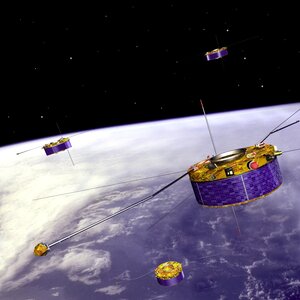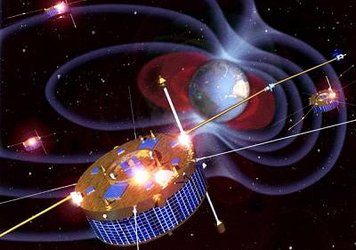ESA’s Cluster satellites in closest-ever ‘dance in space’
Since 2000, the four identical satellites of the Cluster quartet have been probing Earth’s magnetosphere in three dimensions. This week, two of them made their closest-ever approach, just 4 km, enabling valuable data to be acquired with unprecedented detail.
In an orbital reconfiguration that will help to maintain the mission’s life span, two of the four satellites achieved their closest-ever separation on 19 September, closing to within just 4 km of each other as they orbited at up to 23 000 km/h high above Earth.
“We’re optimising the Cluster formation so that the separation between Cluster 1 and the duo of Cluster 3 and 4 – which are on almost identical orbits – is kept below 100 km when the formation crosses Earth’s magnetic equator,” says Detlef Sieg, working on Cluster flight dynamics at ESA’s ESOC operations centre in Darmstadt, Germany.
The formation will hold three of the four satellites close together at lower altitudes, optimising the range of science observations.
New mission record

“Following the closest-ever approach on 30 August, we achieved a new mission record with C1 and C3 yesterday, at just 4.0 km around 09:12 GMT,” says Juergen Volpp, Spacecraft Operations Manager at ESOC.
The main challenge in achieving the formation was to exclude any collision risk and to avoid further manoeuvres, which would interrupt science activities.
“We can determine the satellites’ orbits with an accuracy better than 0.1 km,” says Detlef Sieg, “so we knew we could achieve the formation with sufficient allowance for safety.”
The new formation will be held until early November before the separations are increased to more than 1000 km.
Unprecedented detail
“When we started Cluster, we believed that a separation of 500 km was the smallest required by science,” says ESA’s Phillipe Escoubet, Cluster Mission Scientist.
“However, it turns out that the physical processes at very small scales are very important and this is why we have decided to decrease the separation distance to more than a factor 100 to just 4 km, as it will allow us to study electromagnetic waves in the radiation belts with unprecedented detail.”















 Germany
Germany
 Austria
Austria
 Belgium
Belgium
 Denmark
Denmark
 Spain
Spain
 Estonia
Estonia
 Finland
Finland
 France
France
 Greece
Greece
 Hungary
Hungary
 Ireland
Ireland
 Italy
Italy
 Luxembourg
Luxembourg
 Norway
Norway
 The Netherlands
The Netherlands
 Poland
Poland
 Portugal
Portugal
 Czechia
Czechia
 Romania
Romania
 United Kingdom
United Kingdom
 Slovenia
Slovenia
 Sweden
Sweden
 Switzerland
Switzerland






































